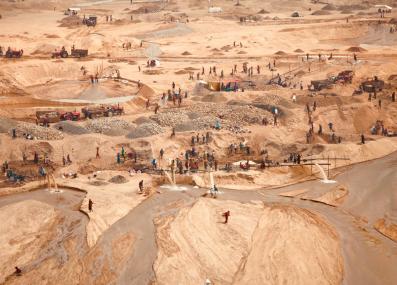Have a question?
How is lithium mined?
Lithium is found in rock ores, which are mined and crushed, or in briny water, where it can be extracted using evaporation.
February 12, 2024
Lithium is an essential component of clean energy technologies, from electric vehicles (EVs) to the big batteries used to store electricity at power plants. It is an abundant mineral, but to be used it must be extracted from the earth and processed.
Today, there are two main ways to pull lithium from the ground. Until recently, most lithium mining occurred in Chile, where lithium is extracted from brines: salty liquid found at the Earth’s surface or underground. To extract lithium, that liquid is pumped from the earth and then placed in pools where the water can evaporate, leaving behind lithium and other elements.
Elsewhere, lithium mining looks more traditional. In 2017, Australia overtook Chile as the dominant lithium producer. Companies there blast a lithium-rich mineral called spodumene out of open pits. Today, Australia produces roughly half of the globe’s supplies.1 More than 80 percent of that rock then travels to China, where it’s further processed to yield lithium.2
Though Australia and Chile dominate production, the rise of clean energy has spurred a growing hunger for lithium, so other mining operations have cropped up in numerous other places. Global lithium production has grown from about 37,000 tonnes a decade ago to 130,000 tonnes in 2022.1,3
“We've just seen an explosion of proposed projects in the planning, piloting, demonstration stage across a much wider array of countries,” says Caroline White-Nockleby, a PhD candidate who studies renewable energy transitions in MIT’s doctoral program in History; Anthropology; and Science, Technology, and Society.
Both brine and hard rock mining come with environmental and social costs. Sixty percent of the world’s lithium stores are located in brine deposits in South America’s “lithium triangle,” sometimes in ecologically sensitive areas.4 Mining of all kinds can disturb landscapes. And though hard rock mining uses more freshwater, both types of mining require significant water use, a resource that may be scarce in certain mining regions.5 In areas of lithium extraction from brine, brine loss is also significant, says White-Nockleby. Because brine is often not considered freshwater suitable for human use, it may have fewer regulatory protections, though mining from it can still impact ecosystems and communities.6
When it comes to energy use, brine mining, which largely uses energy from the sun, is much less intensive than hard rock mining, which requires heavy machinery to dig up and crush rock. The energy used by mining machinery creates climate pollution like carbon dioxide, which warms the planet. A 2021 study found that lithium concentration and production from brine can create about 11 tons of carbon dioxide per ton of lithium, while mining lithium from spodumene ore releases about 37 tons of CO2 per ton of lithium produced.5
The social impacts of lithium mining depend on how mining companies behave and how governments regulate them. Ideally, communities that host lithium mining would share in the economic benefits, and not be left on their own to deal with cleanup and the loss of local resources—though this is far from always the case. Last year, California, where companies are planning to extract lithium from brine, created a law to try to redirect some future mining profits towards local communities. The government will tax lithium extraction at $400 to $800 per ton, which will go to environmental restoration and community benefit projects, as well as directly to counties impacted by extraction.7
The impacts of this policy are yet to be seen, and White-Nockleby urges caution as companies propose more extraction projects across the globe. "Historically and today, lithium mining has disproportionately affected low-income and marginalized communities, and has also often impacted lands with cultural importance to Indigenous communities," she says. “It's important that communities be a part of any lithium mining planning process from the very beginning. People always have the right to reject an extraction project.”
New methods of lithium extraction, which may use less energy and resources, are also being pioneered. In “direct lithium extraction,” specialized filters are used to separate lithium from brine. The process can have a smaller footprint than traditional brine operations, and water can be recycled in the process. White-Nockleby says some companies are also investigating how to pull lithium from old mine waste.
We can also make it easier to mine lithium responsibly, says White-Nockleby, if we find ways to build a new clean energy economy with less lithium. That could involve encouraging people to use public transit (instead of personal cars), minimizing the size of EV batteries, and recycling lithium from old batteries. A 2023 study found that measures like this could reduce U.S. lithium demand by between 18 and 92 percent, while still letting us pursue our climate goals.8
Submit your own question to Ask MIT Climate
Get the latest from Ask MIT Climate monthly in your inbox
1 United States Geological Survey. Mineral Commodity Summaries, January 2023: Lithium.
2 Australian Bureau of Statistics. Insights into Australian Exports of Lithium. April 8, 2022.
3 United States Geological Survey. Mineral Commodity Summaries, January 2013: Lithium.
4 The University of Queensland Sustainable Minerals Institute: "Understanding the social complexities of mining in the Lithium Triangle." May 7, 2023.
5 Kelly, Jarod C., et al., "Energy, greenhouse gas, and water life cycle analysis of lithium carbonate and lithium hydroxide monohydrate from brine and ore resources and their use in lithium ion battery cathodes and lithium ion batteries." Resources, Conservation and Recycling, Volume 174, 2021, doi:10.1016/j.resconrec.2021.105762.
6 Bustos-Gallardo, Beatriz, Gavin Bridge, and Manuel Prieto, "Harvesting Lithium: water, brine and the industrial dynamics of production in the Salar de Atacama," Geoforum, Volume 119, 2021, doi:10.1016/j.geoforum.2021.01.001.
7 California Department of Tax and Fee Administration: Lithium Extraction Excise Tax Guide. Accessed February 12, 2024.
8 Climate and Community Project: Riofrancos, Thea, et al., "Achieving Zero Emissions with More Mobility and Less Mining." January 2023.








